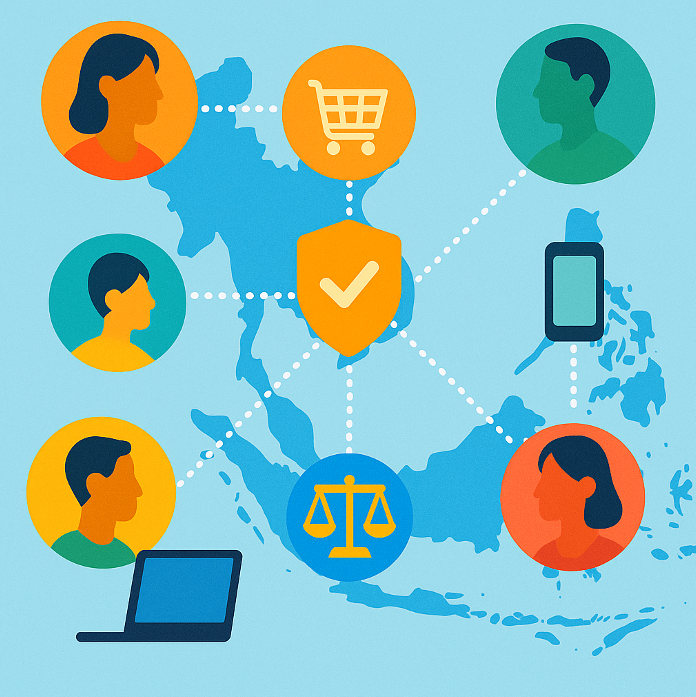By Jon Truby
This blog post is adapted from the author’s presentation at the 10th Biennial Conference of the Asian Society of International Law in Hanoi, Vietnam from 9 to 10 October 2025.
Introduction
Satellites and artificial intelligence (AI) anchor how the world observes climate change and how law and policy respond today. Earth observation (EO) offers objective views of emissions, land use and extreme events. AI turns large datasets into timely information that helps countries build better inventories and informs the global stocktake under the Paris Agreement. Yet the same digital and space systems consume energy and water, create debris risk, and release pollutants from launch and re-entry.
Satellites and AI as core climate infrastructure
EO provides near real-time visibility of greenhouse gases, deforestation, sea level change and disaster impacts. AI supports detection, attribution and rapid damage assessment, strengthening mitigation and adaptation. These capabilities raise credibility in the Paris transparency system by enabling independent checks on national reports and by supplying shared evidence where national capacity is limited. The United Nations Principles Relating to Remote Sensing of the Earth from Outer Space (Remote Sensing Principles) anticipated this role by calling for disclosure of information that could help avert environmental harm and for prompt sharing of disaster-relevant data with affected states. Those principles remain sound in purpose, although they predate commercial high-resolution imaging and the widespread use of AI.
Raising the legal baseline
Recent developments in public international law have strengthened state duties for climate governance. The International Tribunal for the Law of the Sea (ITLOS, the Tribunal), in its ground-breaking advisory opinion (ITLOS AO) delivered in 2024, confirmed that greenhouse gases (GHGs) are “pollution of the marine environment” under the UN Convention on the Law of the Sea (UNCLOS) (para.173, ITLOS AO). States parties to UNCLOS were found to be under a “stringent” due diligence obligation to prevent, reduce and control this pollution (para.241, ITLOS AO). In practical terms, ITLOS interpreted UNCLOS Articles 192 and 194 as requiring states to take “all necessary measures” to combat climate change impacts on the oceans (para.237, ITLOS AO). This effectively raises the baseline. States must intensify efforts to curb emissions across all sectors as part of their duty to protect the marine environment. Significantly, the Tribunal hinted that due diligence extends to emerging sources of emissions like digital infrastructure and satellite launch activities (para. 262-264, ITLOS AO). States cannot ignore the carbon impact of the very technologies used for climate monitoring, whether data centre energy use or rocket fuel combustion, but instead should mitigate those impacts as part of their climate obligations.
In July 2025 the International Court of Justice (ICJ) issued its own advisory opinion on climate change (ICJ AO). The ICJ unequivocally reinforced that states have binding obligations under general international law to protect the climate system and safeguard people from climate harm (para.457, ICJ AO). The Court recognised that these obligations derive not only from climate treaties but also from customary international law and human rights law (para. 112-121, ICJ AO). States must act with due diligence to prevent significant environmental harm, cooperate in good faith, and protect the rights to life and a healthy environment for present and future generations (para.292-296, ICJ AO). Importantly, while advisory opinions are not themselves enforceable, the ICJ made clear that failure to act on climate change breaches existing international law (para.442-444, ICJ AO). Together, the ITLOS and ICJ opinions mark a shift toward stronger legal standards. They signal that in light of the climate crisis, states are expected to use all available tools, including satellite surveillance and AI data, to meet their heightened duty of care. Moreover, governments must address the full scope of their climate footprint, which implicitly includes emissions from digital and space technologies used in climate action. For example, rapidly growing satellite launch rates call for measures like cleaner fuels, reusable rockets and lifecycle emissions accounting as part of the “necessary measures” due diligence demands. Ignoring the environmental externalities of climate-monitoring tech is no longer acceptable under these evolving norms.
Transparency, access and fragmentation
The Paris transparency framework is facilitative and non-punitive. It depends on reliable data that can move across borders in time to inform decisions. Some states favour open access (e.g., the United States and European Union) while others impose strict controls based on security or sovereignty (e.g., China). Fragmentation undermines verification and slows disaster response when speed matters most. Principle XII of the UN Remote Sensing Principles promised sensed state access to data and to available analysed information at reasonable cost, but the framework did not foresee private operators and AI derived products now shaping the market. A modern approach must reconcile sovereignty and privacy with the reality that climate relevant data functions as a global public good.
ASEAN practice
Southeast Asian experience shows how cooperation can work when mission needs are clear. The ASEAN Agreement on Disaster Management and Emergency Response (Disaster Agreement), the ASEAN Coordinating Centre for Humanitarian Assistance on Disaster Management (AHA Centre) and the ASEAN Specialised Meteorological Centre use satellites for early warning and for cross border haze monitoring, building trusted data sharing under agreed safeguards. The ASEAN Framework on Digital Data Governance (Frameworks) and the ASEAN Model Contractual Clauses for Cross-Border Data Flows (Model Contractual Clauses) support responsible cross-border flows for research and operations. Some states retain strong controls on high-resolution imagery, such as Malaysia and Vietnam; others use AI for resilience projects, such as Thailand and the Philippines. Particularly, Singapore links data centre growth to renewable power availability. The region offers practical mechanisms and live experiments that can be scaled.
Updating principles and aligning regimes
The governance task involves both ensuring that climate-relevant information reaches those who need it, that digital and space infrastructures are sustainable. Several updates are feasible. EO can be treated as a public good by updating the Remote Sensing Principles so that states can access data and analysed information for climate and disaster use, with narrow reviewable security exceptions. The Global Digital Compact can be operationalised to support trusted cross-border climate data flows, open access to key datasets and interoperability, while encouraging efficient infrastructure. Embedding digital sustainability in due diligence involves requiring climate impact assessment for launches, constellations and large data centres, linking approvals to renewable power and lifecycle disclosure under Article 206 UNCLOS practice. Methods for analyses that inform inventories or the stocktake should be auditable, with disclosure of data sources and uncertainty for reproduction by designated experts. There is also need to clarify responsibilities in space by modernising practice on interference, data withholding, debris mitigation and post-mission disposal.
Proposals and avenues for reform
Several pathways could help align technology with the raised legal baseline.
1. The Remote Sensing Principles can be updated so that climate and disaster-relevant information is treated as a public good. An update could confirm non-discriminatory access to data at reasonable cost subject to reviewable security exceptions and clear metadata standards.
2. The Global Digital Compact could be used to anchor trusted cross-border climate data flows. This might include commitments on interoperability, governance of datasets that inform the stocktake, and attention to the digital sector’s environmental impact of the.
3. Climate due diligence could be integrated into licensing and procurement for data centres and launch activities. A life cycle approach would help decision makers evaluate energy, water and emissions impacts, consistent with environmental impact assessment practice.
4. Methods that inform national inventories and the stocktake could be expected to meet basic standards of auditability.
5. Responsibilities in space could be clarified through practice and soft law. States might explore expectations on avoiding harmful interference with climate instruments, improving debris mitigation, and enabling timely access to climate-relevant sensing outputs during emergencies.
6. Regional pilots could continue to test practical mechanisms. Climate data corridors with pre‑agreed licences, humanitarian and research exceptions, and common metadata could demonstrate feasibility.
Conclusion
Satellites and AI are now central to credible climate governance in Asia. The legal baseline has been raised through developments that interpret duties to prevent, reduce and control pollution as stringent and proportionate to risk. That change supports proactive use of EO and analytics while requiring attention to the footprint of digital and space activities. By updating access norms, strengthening accountability and drawing on regional practice, states can align powerful technologies with legal duties and equity. The gains are practical. Better evidence, faster warning and more even capacity across the region, achieved in a way that protects the climate system rather than burdening it.
As this baseline takes hold, four questions may guide national reflection:
1. Which measures are necessary and reasonable for our capabilities, including in the digital and space sectors that support climate monitoring?
2. How will we ensure timely access for sensed states to data and analysis-ready information about their territory at reasonable cost while protecting privacy and security?
3. How can a state evidence due diligence for data centres, networks and launch activities, including lifecycle impacts and mitigation plans?
4. What role can regional arrangements play in building trust and capacity so all members can use satellite and analytic outputs effectively?
About the author
Dr Jon Truby is a Visiting Research Associate Professor in AI & Technology Law at the Centre for International Law, National University of Singapore.
Image credit: Freepik





